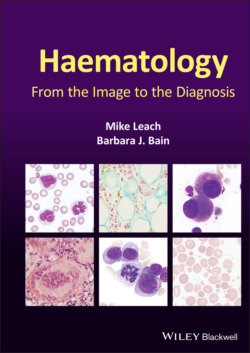Читать книгу Haematology - Barbara J. Bain, Irene Roberts - Страница 12
Оглавление3 Cup‐like blast morphology in acute myeloid leukaemia
A 54‐year‐old woman attended Accident and Emergency with fever, progressive facial pain and bleeding following a tooth extraction 1 week previously. On examination she was systemically unwell and febrile with features of a deep perimandibular soft tissue/tooth socket infection. She had prominent widespread bruising. The full blood count showed Hb 106 g/l, WBC 291 × 109/l, neutrophils 0.7 × 109/l and platelets 49 × 109/l. A coagulation screen showed PT 13 s, APTT 30 s, thrombin time 12.4 s, fibrinogen 1.0 g/l and D dimer 14 059 ng/ml (NR <230). The blood film showed a large population of myeloid blasts. Many of them displayed deep nuclear invaginations (cup‐like morphology) as shown centrally (top left and centre, bottom left and centre) or indenting one side of the nucleus (top left, bottom left and centre) (all images ×100 objective). Some blasts showed small but well‐defined nucleoli (top left, top right and bottom right). There was fine cytoplasmic granulation in some cells and some had Auer rods (top centre and right) whilst a small proportion had pseudo‐Chédiak–Higashi granules (top right, bottom right). The blasts had a CD34−, HLA‐DR−, CD117+, CD13+, CD33+, CD15−, CD14−, CD64+ and MPO+ immunophenotype resembling that often seen in acute promyelocytic leukaemia (APL), but the morphological features were not consistent with this diagnosis. T‐ and B‐lineage markers were not expressed. The karyotype was normal but both NPM1 and FLT3 were mutated with FLT3 showing an internal tandem duplication (FLT3‐ITD).
The clinical presentation here of an acute myeloid leukaemia with bleeding, bruising and coagulopathy together with a CD34−, HLA‐DR−, pan‐myeloid+, CD64+ immunophenotype should lead to consideration of APL as management of this entity clearly differs from that of other AML subtypes. However, a thoughtful examination of the blood film suggests an alternative diagnosis.
MCQ
1 Acute myeloid leukaemia with mutated NPM1 is typically associated with:An abnormal karyotypeCup‐shaped nucleiCytoplasmic expression of NPM1Expression of CD34Poor prognosisFor answers and discussion, see page 206.
